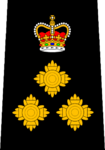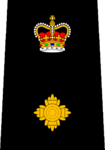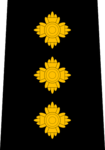British Columbia Sheriff Service
The British Columbia Sheriff Service (BCSS) is a provincial law enforcement agency overseen by the Ministry of the Attorney General in the province of British Columbia, Canada. It is the oldest law enforcement agency in the Province of British Columbia, tracing its roots back to 1857. Sheriffs are Provincial Peace Officers appointed under the BC Sheriff Act and BC Police Act with authority to enforce all relevant federal and provincial acts including the criminal code throughout British Columbia while in the lawful execution of their duties.
| British Columbia Sheriff Service | |
|---|---|
 | |
.jpg) Shoulder Flash | |
| Common name | BC Sheriff Service |
| Abbreviation | BCSS |
| Motto | Honour, Integrity, Commitment |
| Agency overview | |
| Formed | BCSS 1974 |
| Preceding agencies |
|
| Jurisdictional structure | |
| Operations jurisdiction | British Columbia, Canada |
| Size | 944,735 km2 (364,764 sq mi) |
| Population | 5,710,000 |
| Legal jurisdiction | Province of British Columbia |
| Governing body | Ministry of the Attorney General |
| Constituting instrument |
|
| Operational structure | |
| Headquarters | Victoria, BC |
| Deputy Sheriffs | 511 |
| Civilian employees | 30 |
| Elected officer responsible |
|
| Agency executive |
|
| Facilities | |
| Stations | 46 |
| Website | |
| https://www2.gov.bc.ca/gov/content/careers-myhr/job-seekers/featured-careers/deputy-sheriff | |
BC Sheriffs provide protection and enforcement duties in support of the provincial, supreme, and appeal courts in British Columbia.BC Sheriffs provide escort duties, holding cells operations, criminal warrant execution and document services, jury management and protection, undertake Intelligence unit and threat assessment services, provide plainclothes protective operations to those in the justice system or government who are under threat, assist the provincial Coroners Service, deploy strategic response teams to ensure enhanced site protection for those sites or events deemed as high security and BCSS assists local law enforcement agencies with additional resources to ensure public safety such as deployments on Canada Day and under the provincial Emergency Prepardness Program.
History
The history of the BC Sheriffs in this province goes back to the roots of British Columbia. In 1857, Governor James Douglas appointed Andrew Muir as the first Sheriff of the Colony of Vancouver Island. Muir was the first sworn Peace Officer in what is now the Province of British Columbia. The following year, the Gold Rush brought boom times to British Columbia and Muir had his hands full. He was called upon to quash riots and unlawful assemblies as well as to track down lawbreakers. These duties were in addition to his role as coroner, constable, Sgt at Arms and returning officer during Parliamentary elections. In 1860, the Sheriffs Act was created, and the province was divided into nine counties, each with its own High Sheriff.
Early Sheriffs were called on to perform a variety of duties, in some cases serving as the justice of the peace, jailhouse manager, tax collector, government agent and even gold commissioner. It's no surprise that over the years those jobs became specialized, and the administration of justice evolved, this time into a county court system.
In the early to mid-20th century, the role of Sheriff continued to evolve, with duties ranging depending the area of the province in which they served. Some of the more interesting roles included serving as justice of the peace, marrying people in civil ceremonies, and raising the 'hue and cry' and 'posse comitatus' to chase and capture criminals. As late as 1960s, sheriffs were responsible for executing death sentences at the old Okalla prison.
In 1974, the government of the day instituted a significant restructuring of the Office of the Sheriff in British Columbia. Responsibilities were increased and the nine existing County Sheriff Offices were merged into one provincial department called the British Columbia Sheriff Service, and the organization was placed under the Attorney General.
Authorities and duties
BCSS members are Peace Officers who receive their authority from the BC Sheriff Act and BC Police Act as such have authority to enforce provincial and federal statutes. They have the authority throughout the Province of British Columbia while in the lawful execution of their duties.[1]
BCSS members carry out protective and enforcement duties in support of the administration of justice including the protection of the Provincial, Supreme and Appeal Courts of BC, coroner's court, and other official inquiries such as commissions or public hearings.[1] Duties include planning high security trials, assessing and investigating threats towards those employed in the justice system and provincial government, protection of judges, crown prosecutors and those employed by government, managing detention cells, transportation of prisoners by ground and air, manage and provide protection for juries, serve court-related documents, execute court orders, and execute criminal and civil warrants, provide members to the B.C. Fugitive Return Program[2] BCSS will also assist local Law Enforcement agencies with additional resources to ensure public safety such as Canada Day deployments.
As of Spring 2019 BCSS members have a duty and responsibility to act in exigent circumstances to intervene in life-threatening situations they encounter in the course of their duties.[3]
Rank structure[4]
- Recruit Sheriff
- Deputy Sheriff
- Sergeant
- Staff Sergeant
- Inspector
- Staff Inspector
- Superintendent
- Deputy Chief
- Chief Sheriff
The rank structure and insignia consists of the following:
| RANKS | Chief Sheriff | Deputy Chief | Superintendent | Staff Inspector | Inspector | Staff Sergeant | Sergeant | Deputy Sheriff | Recruit Sheriff |
|---|---|---|---|---|---|---|---|---|---|
| INSIGNIA |  |
 |
 |
 |
 |
Recruiting and training
Recruiting of new Sheriffs Deputies is handled by the Service's Recruiting & Selection Unit. Applicants must show a safe driving record, pass the Sheriff Officer Physical Abilities Test, have an LPI 5 English proficiency, typing test and pass a comprehensive background investigation which includes a past-work performance reference check, interview process, enhanced security screening, comprehensive medical examination, vision and hearing testing and voice stress analysis testing.[4]
Recruit training is conducted at the Sheriff Academy at the Justice Institute of British Columbia. Recruits undergo a fourteen-week training program broken into Block I and II. Block I takes place at the Justice Institute in New Westminster and consists of training in emergency vehicle driver training, firearms, force response options, active shooter training and team deployments, conducted energy weapons (Tasers), communications, legal studies, report writing, controlled access points, roles & functions, intelligence, cultural awareness, dress and deportment and physical fitness. In block II, recruits enter the field under the direction of a training officer, who will also complete an evaluation. In order for a recruit to progress to the rank of Deputy Sheriff they must successfully complete both block I & II.[5]
Specialized units
Sheriffs Provincial Operations Centre (S.P.O.C.) houses the provincial dispatch centre for BCSS, C.P.I.C. data base, provincial fleet operations, Fugitive Return Program and lower mainland escort section.
Specialized Units such as the Integrated Threat Assessment Unit (ITAU) have duties including assessing threats towards government and public officials, gathering intelligence and working in integrated partnerships with other Law Enforcement agencies to assess and manage intelligence. ITAU also manages and assists with operational planning.
The Protective Operations Unit (P.O.U.), overseen by ITAU, whose mandate includes the protection of individuals who may be at risk due to the nature of their work, have received inappropriate communications, have been threatened, or have been identified as requiring protection. Protective Operations members receive highly advanced training in close quarter protection and operate as a plain clothes unit. Protective Operations may include infrastructure and vulnerability assessments, personal protection, transport operations, residential, site, and special event protection.[6]
Intelligence Members of BCSS are embedded at several Integrated provincial agencies including R.T.I.C. (Real Time Intelligence Centre) whose primary role is to track and monitor organized crime, gangs and other groups in the province, real time crimes in progress and direct threats to public safety including terrorism related events throughout the province.[7]
Fugitive Return Program Specialized Units also execute outstanding warrants on persons wanted in other Provincial jurisdictions and escort those persons back to other Canadian jurisdictions (Con Air Program). These specialized operations include members operating in plain clothes with enhanced training and experience related to this specific detail. BCSS members also fly to other provincial jurisdictions arrest and return fugitives wanted in British Columbia.[8]
Strategic Operations Teams are highly trained members of BCSS who are trained in the use of elevated weapons platforms (long guns), counter surveillance, strategic motorcade operations and operators are deployed to provide enhanced site protection for areas deemed vulnerable to elevated threat levels.
Sheriff Ceremonial Unit
The BCSS Ceremonial Unit (C.U.) is composed of serving and retired sworn members of the Service. The unit represent BCSS at funerals, ceremonial events, parades, special functions for government and graduation ceremonies for Sheriffs Academy recruit classes. Members participate on a voluntary basis. The C.U. has a distinctive black high neck dress tunic with a red stripe on the pants and is designed as a bridge between the heritage of the historic office of the Sheriff in England and the modern day BCSS.[1]
References
- "About the BC Sheriff Services". gov.bc.ca. Government of British Columbia. Retrieved 6 May 2018.
- "Deputy Sheriff Position Description" (PDF). gov.bc.ca. Government of British Columbia. Retrieved 6 May 2018.
- http://www.bclaws.ca/Recon/document/ID/freeside/12_263_2009
- "Deputy Sheriff Career Opportunities". gov.bc.ca. Government of British Columbia. Retrieved 6 May 2018.
- "Sheriff Academy". jibc.ca. Justice Institute of British Columbia. Retrieved 6 May 2018.
- "B.C. Sheriff Services - Integrated Threat Assessment Unit (ITAU)". gov.bc.ca. Government of British Columbia. Retrieved 6 May 2018.
- "RCMP RTIC Presentation". mapleridge.ca. City of Maple Ridge. Archived from the original on 7 May 2018. Retrieved 6 May 2018.
- BCSS return wanted fugitives. 2009 World Police & Fire Games. Retrieved 15 November 2008. Archived 20 September 2008 at the Wayback Machine